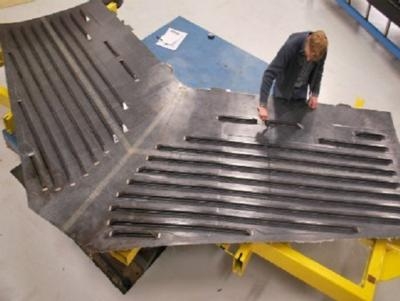Sun, Jan 26, 2014
Agreement Carries Collaboration Through 2017
Airbus, Fokker and TenCate have signed a contract for the next stage of the Thermoplastic Affordable Primary Aircraft Structure innovation program (TAPAS), in the presence of the French President François Hollande, the Dutch Prime Minister Mark Rutte and Minister of Economic Affairs Henk Kamp. This program, in existence since 2010, is considered a highly successful tool for project-based innovation partnerships.

The TAPAS consortium consists of companies and knowledge institutes in the Dutch aerospace industry working together with Airbus on the development of thermoplastic composite applications in aircraft fuselages, wings and tail sections. The partnership between Fokker Aerostructures and TenCate Advanced Composites with Airbus and the other partners started in 2010 and, following the new extension, will run until end-2017. The innovation partners within TAPAS from Dutch SME’s are Airborne Composites, CODET, DTC, KE-Works, KVE and Technobis Fiber Technologies. The Netherlands National Aerospace Laboratory (NLR), Delft University of Technology and the University of Twente are the Dutch knowledge partners in this innovation program.
Thermoplastic composites are advanced materials offering weight savings of 15% compared with traditional aircraft materials, together with benefits that include more efficient processing in production, lower costs of structural components and a high level of fire safety. These composites have high strength, light weight and contribute to the drive towards sustainable aviation, because the use of these materials allows constant reductions in aircraft weight to be achieved. As a result fuel consumption is reduced, the range of the aircraft is increased and higher payloads are possible. The target is to further increase the proportion of thermoplastic composites in current aircraft as well as in the new generation of aircraft. A demonstration tail section made entirely of thermoplastic composite material is being developed under the TAPAS 2 agreement. A thermoplastic fuselage panel has been produced and presented as demonstrator as part of TAPAS 1.
(Image provided by TenCate)
More News
Aero Linx: American Aviation Historical Society AAHS is dedicated to the preservation and dissemination of the rich heritage of American aviation. Our purpose is to collect, preser>[...]
CrewMember (UAS) A person assigned to perform an operational duty. A UAS crewmember includes the remote pilot in command, the person manipulating the controls, and visual observers>[...]
Immediately After The Right Main Tire Contacted The Runway Surface, The Right Main Landing Gear Failed On October 31, 2025, at about 1227 Pacific daylight time, a Maule M-7-235A, N>[...]
Also: IAE Acquires Diamond Trainers, Army Drones, FedEx Pilots Warning, DA62 MPP To Dresden Tech Uni The danger to the flight training industry and our future pilots is clear. Dona>[...]
"On December 3, 2025, at approximately 10:45 a.m., a Thunderbird pilot ejected safely from a F-16C Fighting Falcon aircraft during a training mission over controlled airspace in Ca>[...]
 ANN's Daily Aero-Linx (12.03.25)
ANN's Daily Aero-Linx (12.03.25) ANN's Daily Aero-Term (12.03.25): CrewMember (UAS)
ANN's Daily Aero-Term (12.03.25): CrewMember (UAS) NTSB Prelim: Maule M-7-235A
NTSB Prelim: Maule M-7-235A Airborne-Flight Training 12.04.25: Ldg Fee Danger, Av Mental Health, PC-7 MKX
Airborne-Flight Training 12.04.25: Ldg Fee Danger, Av Mental Health, PC-7 MKX Aero-News: Quote of the Day (12.04.25)
Aero-News: Quote of the Day (12.04.25)



